UK Law and Business: Legislation, Organizations, and Dispute Solutions
VerifiedAdded on 2022/11/25
|13
|3819
|448
Report
AI Summary
This report provides an overview of the English legal system and its impact on businesses. It covers various sources of law in the UK, including statutory and common law, and explains the law-making process. The report discusses the impact of different business legislations, such as contract law, employment law, and company law, on business operations. It further examines the legal formation of various business organizations, including sole proprietorships, partnerships, and companies, detailing their liabilities and management structures. Finally, it recommends different legal solutions for resolving business disputes, highlighting the importance of understanding and adhering to legal frameworks for effective business management. Desklib offers additional resources for students.

7
Paraphrase This Document
Need a fresh take? Get an instant paraphrase of this document with our AI Paraphraser
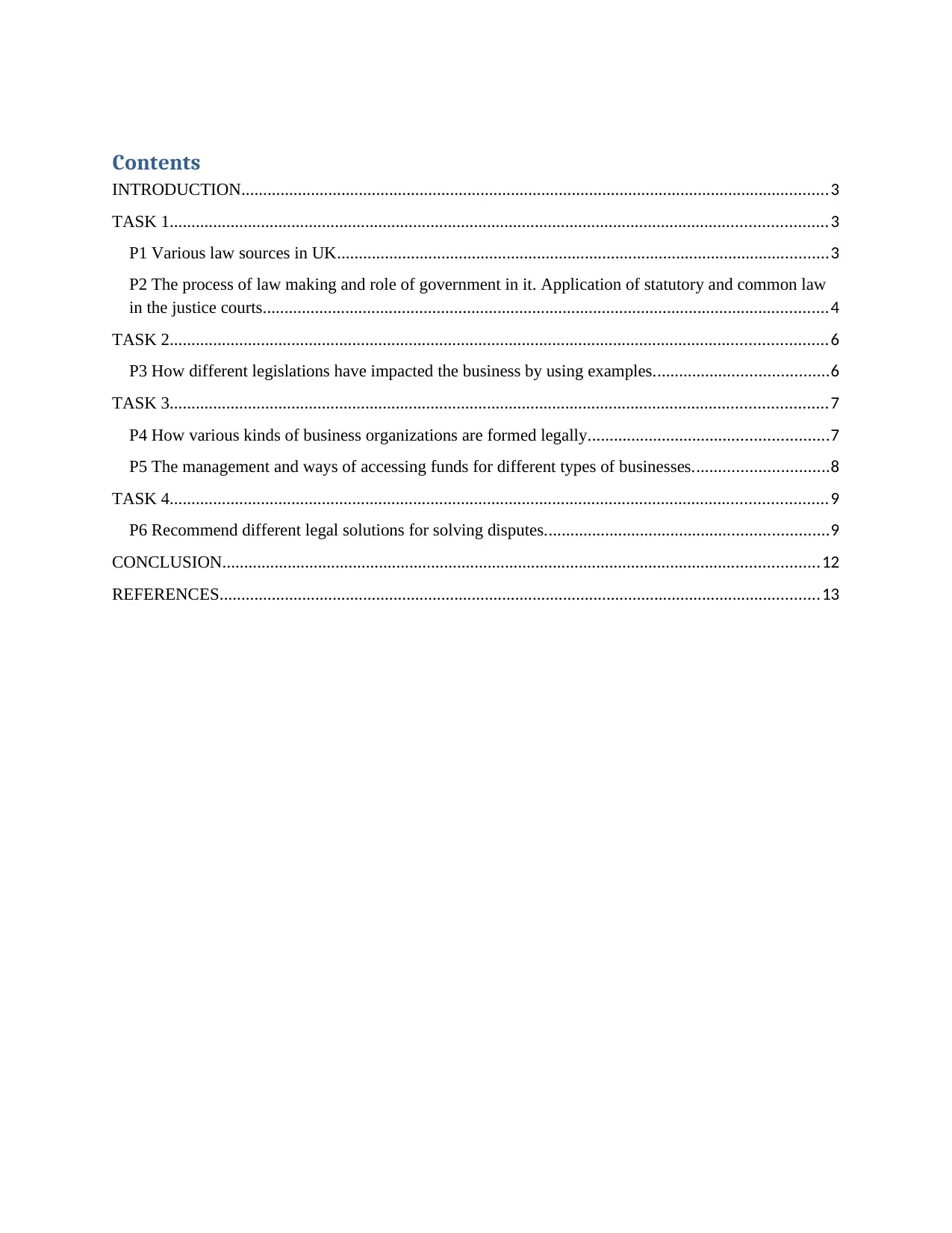
Contents
INTRODUCTION.......................................................................................................................................3
TASK 1.......................................................................................................................................................3
P1 Various law sources in UK.................................................................................................................3
P2 The process of law making and role of government in it. Application of statutory and common law
in the justice courts..................................................................................................................................4
TASK 2.......................................................................................................................................................6
P3 How different legislations have impacted the business by using examples........................................6
TASK 3.......................................................................................................................................................7
P4 How various kinds of business organizations are formed legally.......................................................7
P5 The management and ways of accessing funds for different types of businesses...............................8
TASK 4.......................................................................................................................................................9
P6 Recommend different legal solutions for solving disputes.................................................................9
CONCLUSION.........................................................................................................................................12
REFERENCES..........................................................................................................................................13
INTRODUCTION.......................................................................................................................................3
TASK 1.......................................................................................................................................................3
P1 Various law sources in UK.................................................................................................................3
P2 The process of law making and role of government in it. Application of statutory and common law
in the justice courts..................................................................................................................................4
TASK 2.......................................................................................................................................................6
P3 How different legislations have impacted the business by using examples........................................6
TASK 3.......................................................................................................................................................7
P4 How various kinds of business organizations are formed legally.......................................................7
P5 The management and ways of accessing funds for different types of businesses...............................8
TASK 4.......................................................................................................................................................9
P6 Recommend different legal solutions for solving disputes.................................................................9
CONCLUSION.........................................................................................................................................12
REFERENCES..........................................................................................................................................13
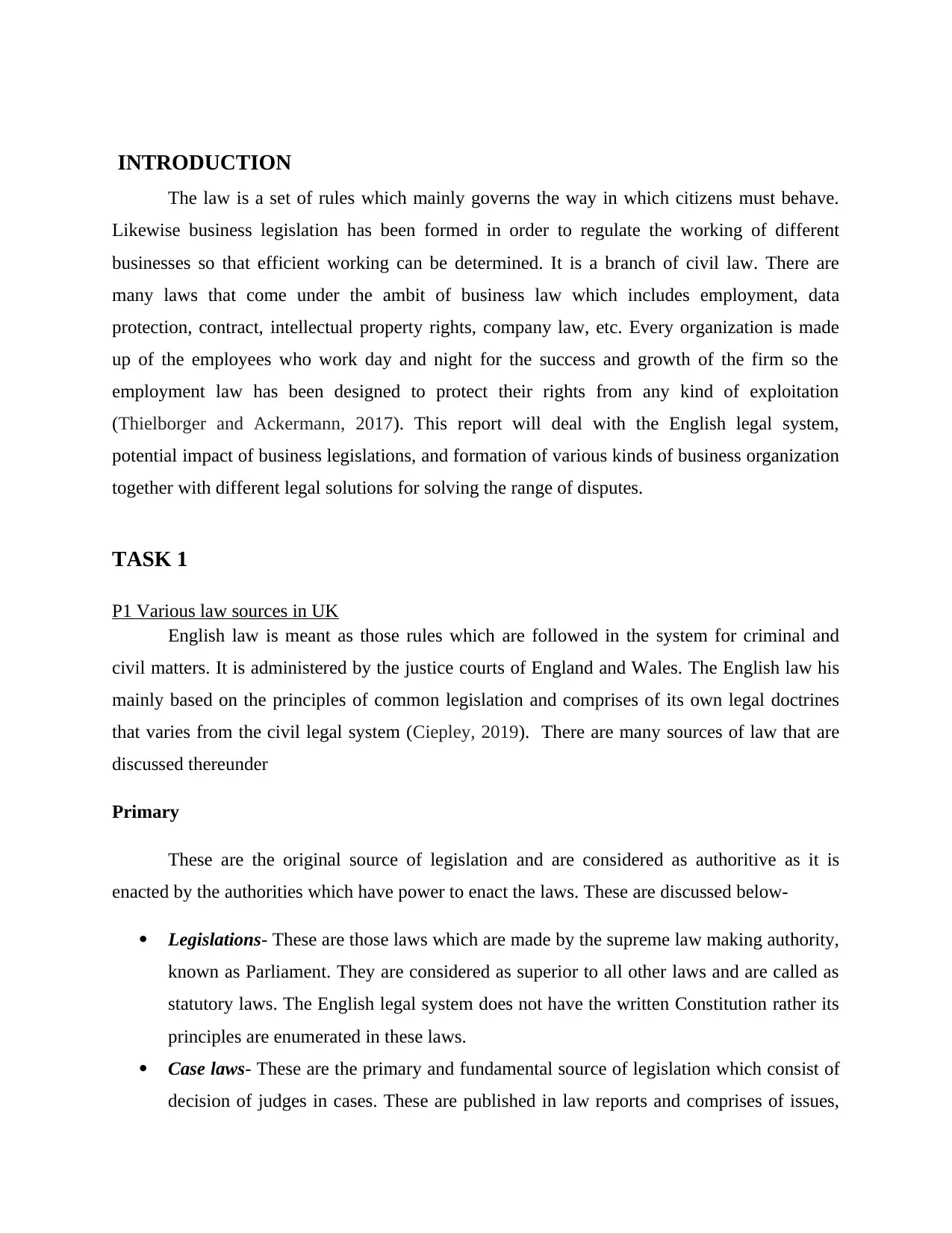
INTRODUCTION
The law is a set of rules which mainly governs the way in which citizens must behave.
Likewise business legislation has been formed in order to regulate the working of different
businesses so that efficient working can be determined. It is a branch of civil law. There are
many laws that come under the ambit of business law which includes employment, data
protection, contract, intellectual property rights, company law, etc. Every organization is made
up of the employees who work day and night for the success and growth of the firm so the
employment law has been designed to protect their rights from any kind of exploitation
(Thielborger and Ackermann, 2017). This report will deal with the English legal system,
potential impact of business legislations, and formation of various kinds of business organization
together with different legal solutions for solving the range of disputes.
TASK 1
P1 Various law sources in UK
English law is meant as those rules which are followed in the system for criminal and
civil matters. It is administered by the justice courts of England and Wales. The English law his
mainly based on the principles of common legislation and comprises of its own legal doctrines
that varies from the civil legal system (Ciepley, 2019). There are many sources of law that are
discussed thereunder
Primary
These are the original source of legislation and are considered as authoritive as it is
enacted by the authorities which have power to enact the laws. These are discussed below-
Legislations- These are those laws which are made by the supreme law making authority,
known as Parliament. They are considered as superior to all other laws and are called as
statutory laws. The English legal system does not have the written Constitution rather its
principles are enumerated in these laws.
Case laws- These are the primary and fundamental source of legislation which consist of
decision of judges in cases. These are published in law reports and comprises of issues,
The law is a set of rules which mainly governs the way in which citizens must behave.
Likewise business legislation has been formed in order to regulate the working of different
businesses so that efficient working can be determined. It is a branch of civil law. There are
many laws that come under the ambit of business law which includes employment, data
protection, contract, intellectual property rights, company law, etc. Every organization is made
up of the employees who work day and night for the success and growth of the firm so the
employment law has been designed to protect their rights from any kind of exploitation
(Thielborger and Ackermann, 2017). This report will deal with the English legal system,
potential impact of business legislations, and formation of various kinds of business organization
together with different legal solutions for solving the range of disputes.
TASK 1
P1 Various law sources in UK
English law is meant as those rules which are followed in the system for criminal and
civil matters. It is administered by the justice courts of England and Wales. The English law his
mainly based on the principles of common legislation and comprises of its own legal doctrines
that varies from the civil legal system (Ciepley, 2019). There are many sources of law that are
discussed thereunder
Primary
These are the original source of legislation and are considered as authoritive as it is
enacted by the authorities which have power to enact the laws. These are discussed below-
Legislations- These are those laws which are made by the supreme law making authority,
known as Parliament. They are considered as superior to all other laws and are called as
statutory laws. The English legal system does not have the written Constitution rather its
principles are enumerated in these laws.
Case laws- These are the primary and fundamental source of legislation which consist of
decision of judges in cases. These are published in law reports and comprises of issues,
⊘ This is a preview!⊘
Do you want full access?
Subscribe today to unlock all pages.

Trusted by 1+ million students worldwide
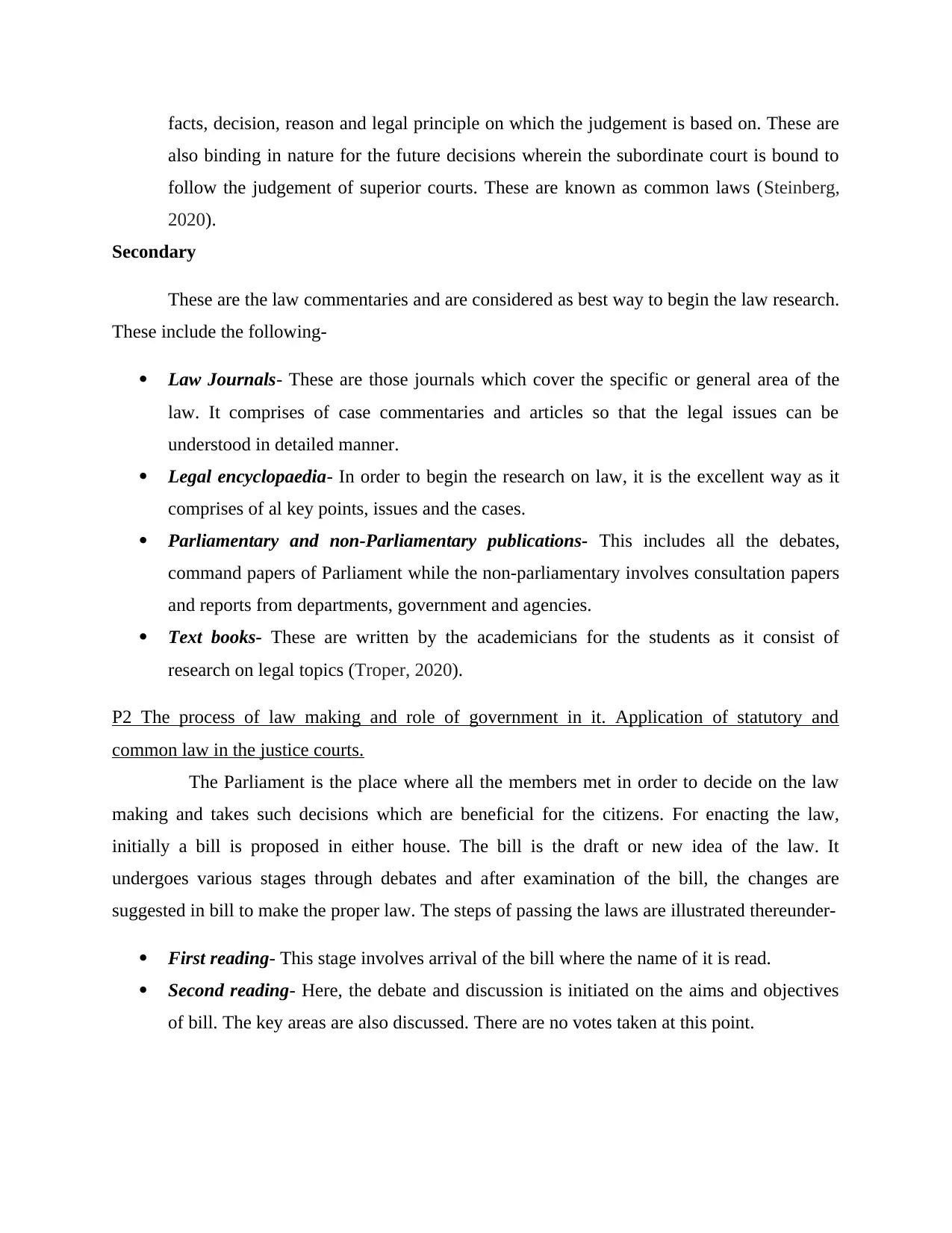
facts, decision, reason and legal principle on which the judgement is based on. These are
also binding in nature for the future decisions wherein the subordinate court is bound to
follow the judgement of superior courts. These are known as common laws (Steinberg,
2020).
Secondary
These are the law commentaries and are considered as best way to begin the law research.
These include the following-
Law Journals- These are those journals which cover the specific or general area of the
law. It comprises of case commentaries and articles so that the legal issues can be
understood in detailed manner.
Legal encyclopaedia- In order to begin the research on law, it is the excellent way as it
comprises of al key points, issues and the cases.
Parliamentary and non-Parliamentary publications- This includes all the debates,
command papers of Parliament while the non-parliamentary involves consultation papers
and reports from departments, government and agencies.
Text books- These are written by the academicians for the students as it consist of
research on legal topics (Troper, 2020).
P2 The process of law making and role of government in it. Application of statutory and
common law in the justice courts.
The Parliament is the place where all the members met in order to decide on the law
making and takes such decisions which are beneficial for the citizens. For enacting the law,
initially a bill is proposed in either house. The bill is the draft or new idea of the law. It
undergoes various stages through debates and after examination of the bill, the changes are
suggested in bill to make the proper law. The steps of passing the laws are illustrated thereunder-
First reading- This stage involves arrival of the bill where the name of it is read.
Second reading- Here, the debate and discussion is initiated on the aims and objectives
of bill. The key areas are also discussed. There are no votes taken at this point.
also binding in nature for the future decisions wherein the subordinate court is bound to
follow the judgement of superior courts. These are known as common laws (Steinberg,
2020).
Secondary
These are the law commentaries and are considered as best way to begin the law research.
These include the following-
Law Journals- These are those journals which cover the specific or general area of the
law. It comprises of case commentaries and articles so that the legal issues can be
understood in detailed manner.
Legal encyclopaedia- In order to begin the research on law, it is the excellent way as it
comprises of al key points, issues and the cases.
Parliamentary and non-Parliamentary publications- This includes all the debates,
command papers of Parliament while the non-parliamentary involves consultation papers
and reports from departments, government and agencies.
Text books- These are written by the academicians for the students as it consist of
research on legal topics (Troper, 2020).
P2 The process of law making and role of government in it. Application of statutory and
common law in the justice courts.
The Parliament is the place where all the members met in order to decide on the law
making and takes such decisions which are beneficial for the citizens. For enacting the law,
initially a bill is proposed in either house. The bill is the draft or new idea of the law. It
undergoes various stages through debates and after examination of the bill, the changes are
suggested in bill to make the proper law. The steps of passing the laws are illustrated thereunder-
First reading- This stage involves arrival of the bill where the name of it is read.
Second reading- Here, the debate and discussion is initiated on the aims and objectives
of bill. The key areas are also discussed. There are no votes taken at this point.
Paraphrase This Document
Need a fresh take? Get an instant paraphrase of this document with our AI Paraphraser
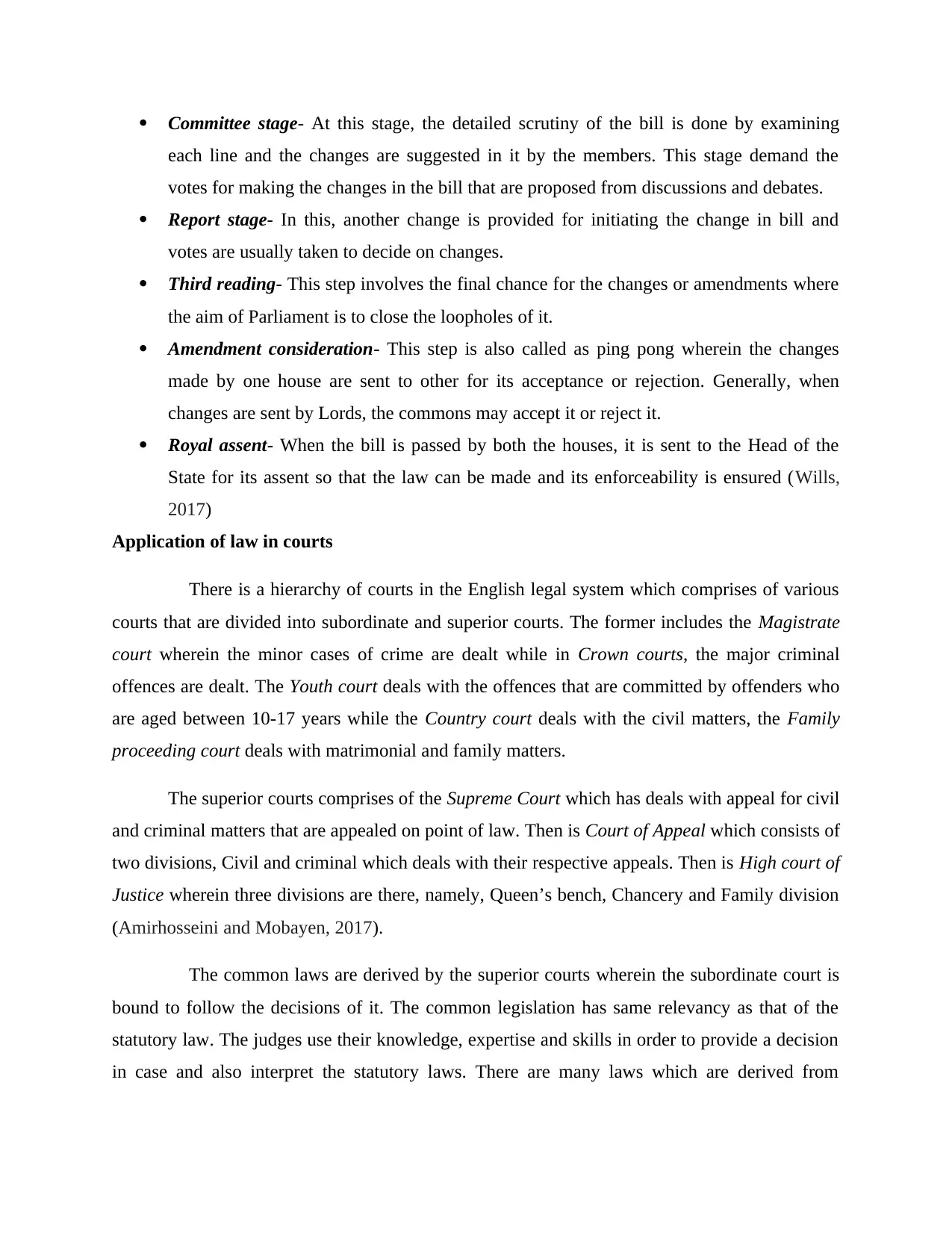
Committee stage- At this stage, the detailed scrutiny of the bill is done by examining
each line and the changes are suggested in it by the members. This stage demand the
votes for making the changes in the bill that are proposed from discussions and debates.
Report stage- In this, another change is provided for initiating the change in bill and
votes are usually taken to decide on changes.
Third reading- This step involves the final chance for the changes or amendments where
the aim of Parliament is to close the loopholes of it.
Amendment consideration- This step is also called as ping pong wherein the changes
made by one house are sent to other for its acceptance or rejection. Generally, when
changes are sent by Lords, the commons may accept it or reject it.
Royal assent- When the bill is passed by both the houses, it is sent to the Head of the
State for its assent so that the law can be made and its enforceability is ensured (Wills,
2017)
Application of law in courts
There is a hierarchy of courts in the English legal system which comprises of various
courts that are divided into subordinate and superior courts. The former includes the Magistrate
court wherein the minor cases of crime are dealt while in Crown courts, the major criminal
offences are dealt. The Youth court deals with the offences that are committed by offenders who
are aged between 10-17 years while the Country court deals with the civil matters, the Family
proceeding court deals with matrimonial and family matters.
The superior courts comprises of the Supreme Court which has deals with appeal for civil
and criminal matters that are appealed on point of law. Then is Court of Appeal which consists of
two divisions, Civil and criminal which deals with their respective appeals. Then is High court of
Justice wherein three divisions are there, namely, Queen’s bench, Chancery and Family division
(Amirhosseini and Mobayen, 2017).
The common laws are derived by the superior courts wherein the subordinate court is
bound to follow the decisions of it. The common legislation has same relevancy as that of the
statutory law. The judges use their knowledge, expertise and skills in order to provide a decision
in case and also interpret the statutory laws. There are many laws which are derived from
each line and the changes are suggested in it by the members. This stage demand the
votes for making the changes in the bill that are proposed from discussions and debates.
Report stage- In this, another change is provided for initiating the change in bill and
votes are usually taken to decide on changes.
Third reading- This step involves the final chance for the changes or amendments where
the aim of Parliament is to close the loopholes of it.
Amendment consideration- This step is also called as ping pong wherein the changes
made by one house are sent to other for its acceptance or rejection. Generally, when
changes are sent by Lords, the commons may accept it or reject it.
Royal assent- When the bill is passed by both the houses, it is sent to the Head of the
State for its assent so that the law can be made and its enforceability is ensured (Wills,
2017)
Application of law in courts
There is a hierarchy of courts in the English legal system which comprises of various
courts that are divided into subordinate and superior courts. The former includes the Magistrate
court wherein the minor cases of crime are dealt while in Crown courts, the major criminal
offences are dealt. The Youth court deals with the offences that are committed by offenders who
are aged between 10-17 years while the Country court deals with the civil matters, the Family
proceeding court deals with matrimonial and family matters.
The superior courts comprises of the Supreme Court which has deals with appeal for civil
and criminal matters that are appealed on point of law. Then is Court of Appeal which consists of
two divisions, Civil and criminal which deals with their respective appeals. Then is High court of
Justice wherein three divisions are there, namely, Queen’s bench, Chancery and Family division
(Amirhosseini and Mobayen, 2017).
The common laws are derived by the superior courts wherein the subordinate court is
bound to follow the decisions of it. The common legislation has same relevancy as that of the
statutory law. The judges use their knowledge, expertise and skills in order to provide a decision
in case and also interpret the statutory laws. There are many laws which are derived from
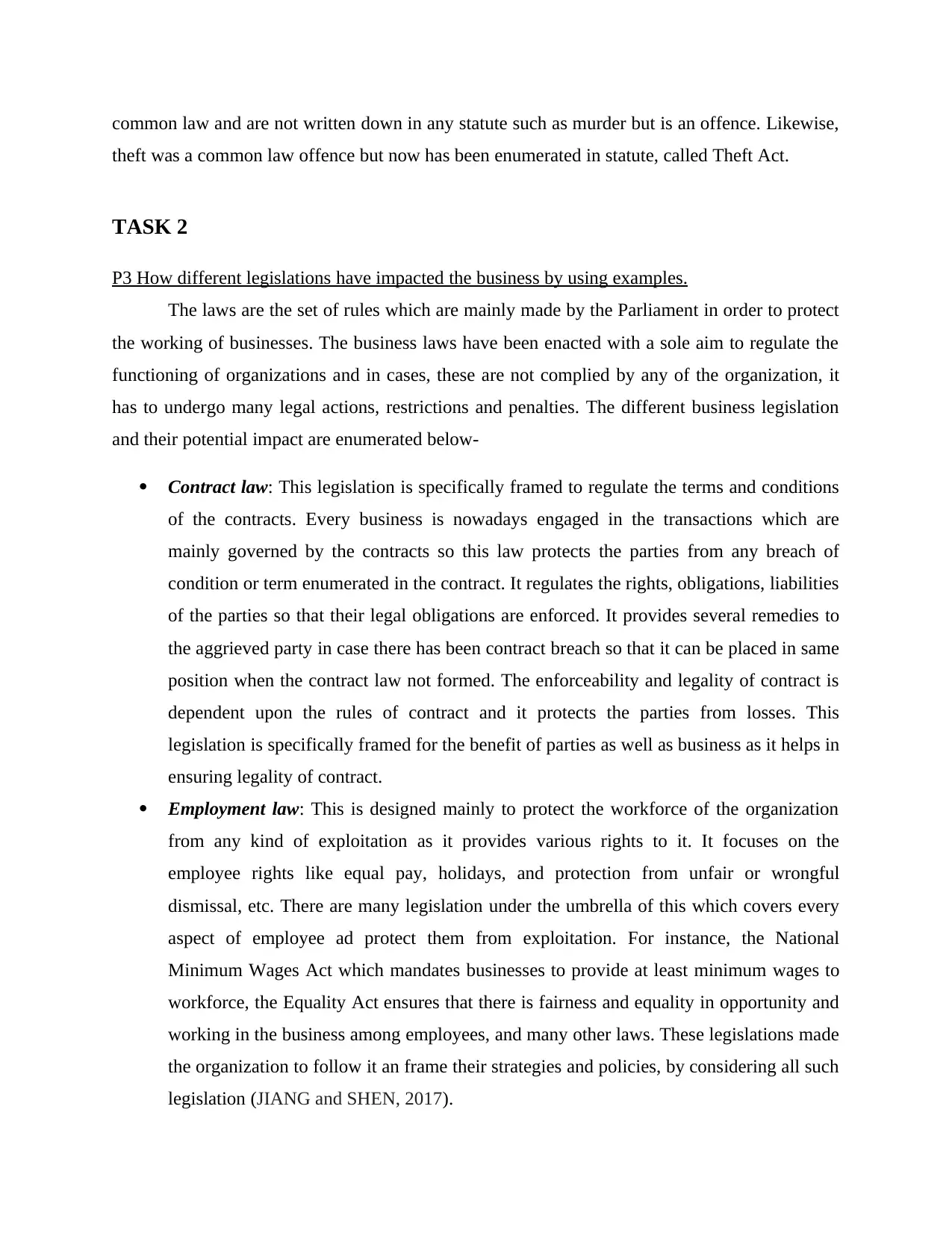
common law and are not written down in any statute such as murder but is an offence. Likewise,
theft was a common law offence but now has been enumerated in statute, called Theft Act.
TASK 2
P3 How different legislations have impacted the business by using examples.
The laws are the set of rules which are mainly made by the Parliament in order to protect
the working of businesses. The business laws have been enacted with a sole aim to regulate the
functioning of organizations and in cases, these are not complied by any of the organization, it
has to undergo many legal actions, restrictions and penalties. The different business legislation
and their potential impact are enumerated below-
Contract law: This legislation is specifically framed to regulate the terms and conditions
of the contracts. Every business is nowadays engaged in the transactions which are
mainly governed by the contracts so this law protects the parties from any breach of
condition or term enumerated in the contract. It regulates the rights, obligations, liabilities
of the parties so that their legal obligations are enforced. It provides several remedies to
the aggrieved party in case there has been contract breach so that it can be placed in same
position when the contract law not formed. The enforceability and legality of contract is
dependent upon the rules of contract and it protects the parties from losses. This
legislation is specifically framed for the benefit of parties as well as business as it helps in
ensuring legality of contract.
Employment law: This is designed mainly to protect the workforce of the organization
from any kind of exploitation as it provides various rights to it. It focuses on the
employee rights like equal pay, holidays, and protection from unfair or wrongful
dismissal, etc. There are many legislation under the umbrella of this which covers every
aspect of employee ad protect them from exploitation. For instance, the National
Minimum Wages Act which mandates businesses to provide at least minimum wages to
workforce, the Equality Act ensures that there is fairness and equality in opportunity and
working in the business among employees, and many other laws. These legislations made
the organization to follow it an frame their strategies and policies, by considering all such
legislation (JIANG and SHEN, 2017).
theft was a common law offence but now has been enumerated in statute, called Theft Act.
TASK 2
P3 How different legislations have impacted the business by using examples.
The laws are the set of rules which are mainly made by the Parliament in order to protect
the working of businesses. The business laws have been enacted with a sole aim to regulate the
functioning of organizations and in cases, these are not complied by any of the organization, it
has to undergo many legal actions, restrictions and penalties. The different business legislation
and their potential impact are enumerated below-
Contract law: This legislation is specifically framed to regulate the terms and conditions
of the contracts. Every business is nowadays engaged in the transactions which are
mainly governed by the contracts so this law protects the parties from any breach of
condition or term enumerated in the contract. It regulates the rights, obligations, liabilities
of the parties so that their legal obligations are enforced. It provides several remedies to
the aggrieved party in case there has been contract breach so that it can be placed in same
position when the contract law not formed. The enforceability and legality of contract is
dependent upon the rules of contract and it protects the parties from losses. This
legislation is specifically framed for the benefit of parties as well as business as it helps in
ensuring legality of contract.
Employment law: This is designed mainly to protect the workforce of the organization
from any kind of exploitation as it provides various rights to it. It focuses on the
employee rights like equal pay, holidays, and protection from unfair or wrongful
dismissal, etc. There are many legislation under the umbrella of this which covers every
aspect of employee ad protect them from exploitation. For instance, the National
Minimum Wages Act which mandates businesses to provide at least minimum wages to
workforce, the Equality Act ensures that there is fairness and equality in opportunity and
working in the business among employees, and many other laws. These legislations made
the organization to follow it an frame their strategies and policies, by considering all such
legislation (JIANG and SHEN, 2017).
⊘ This is a preview!⊘
Do you want full access?
Subscribe today to unlock all pages.

Trusted by 1+ million students worldwide
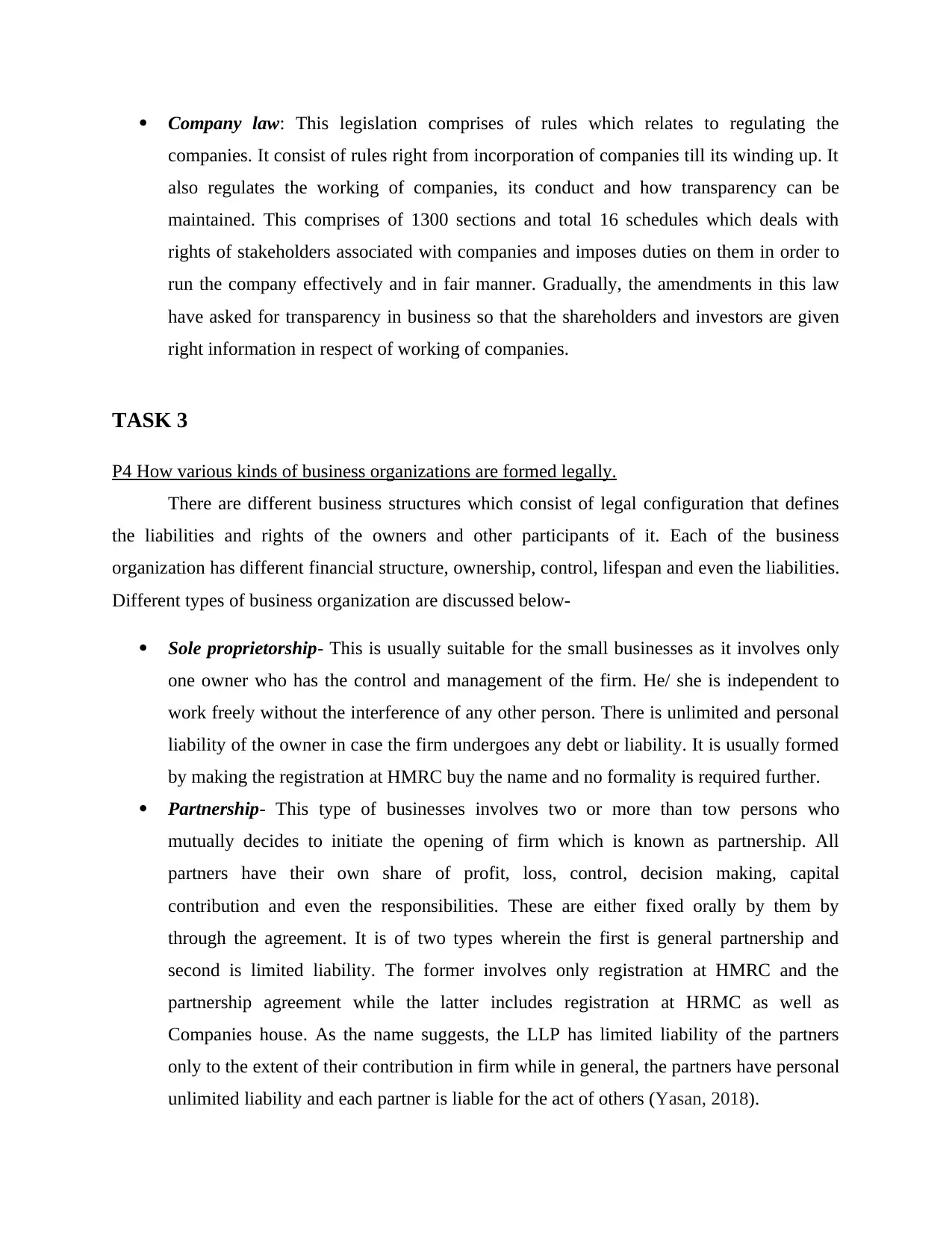
Company law: This legislation comprises of rules which relates to regulating the
companies. It consist of rules right from incorporation of companies till its winding up. It
also regulates the working of companies, its conduct and how transparency can be
maintained. This comprises of 1300 sections and total 16 schedules which deals with
rights of stakeholders associated with companies and imposes duties on them in order to
run the company effectively and in fair manner. Gradually, the amendments in this law
have asked for transparency in business so that the shareholders and investors are given
right information in respect of working of companies.
TASK 3
P4 How various kinds of business organizations are formed legally.
There are different business structures which consist of legal configuration that defines
the liabilities and rights of the owners and other participants of it. Each of the business
organization has different financial structure, ownership, control, lifespan and even the liabilities.
Different types of business organization are discussed below-
Sole proprietorship- This is usually suitable for the small businesses as it involves only
one owner who has the control and management of the firm. He/ she is independent to
work freely without the interference of any other person. There is unlimited and personal
liability of the owner in case the firm undergoes any debt or liability. It is usually formed
by making the registration at HMRC buy the name and no formality is required further.
Partnership- This type of businesses involves two or more than tow persons who
mutually decides to initiate the opening of firm which is known as partnership. All
partners have their own share of profit, loss, control, decision making, capital
contribution and even the responsibilities. These are either fixed orally by them by
through the agreement. It is of two types wherein the first is general partnership and
second is limited liability. The former involves only registration at HMRC and the
partnership agreement while the latter includes registration at HRMC as well as
Companies house. As the name suggests, the LLP has limited liability of the partners
only to the extent of their contribution in firm while in general, the partners have personal
unlimited liability and each partner is liable for the act of others (Yasan, 2018).
companies. It consist of rules right from incorporation of companies till its winding up. It
also regulates the working of companies, its conduct and how transparency can be
maintained. This comprises of 1300 sections and total 16 schedules which deals with
rights of stakeholders associated with companies and imposes duties on them in order to
run the company effectively and in fair manner. Gradually, the amendments in this law
have asked for transparency in business so that the shareholders and investors are given
right information in respect of working of companies.
TASK 3
P4 How various kinds of business organizations are formed legally.
There are different business structures which consist of legal configuration that defines
the liabilities and rights of the owners and other participants of it. Each of the business
organization has different financial structure, ownership, control, lifespan and even the liabilities.
Different types of business organization are discussed below-
Sole proprietorship- This is usually suitable for the small businesses as it involves only
one owner who has the control and management of the firm. He/ she is independent to
work freely without the interference of any other person. There is unlimited and personal
liability of the owner in case the firm undergoes any debt or liability. It is usually formed
by making the registration at HMRC buy the name and no formality is required further.
Partnership- This type of businesses involves two or more than tow persons who
mutually decides to initiate the opening of firm which is known as partnership. All
partners have their own share of profit, loss, control, decision making, capital
contribution and even the responsibilities. These are either fixed orally by them by
through the agreement. It is of two types wherein the first is general partnership and
second is limited liability. The former involves only registration at HMRC and the
partnership agreement while the latter includes registration at HRMC as well as
Companies house. As the name suggests, the LLP has limited liability of the partners
only to the extent of their contribution in firm while in general, the partners have personal
unlimited liability and each partner is liable for the act of others (Yasan, 2018).
Paraphrase This Document
Need a fresh take? Get an instant paraphrase of this document with our AI Paraphraser
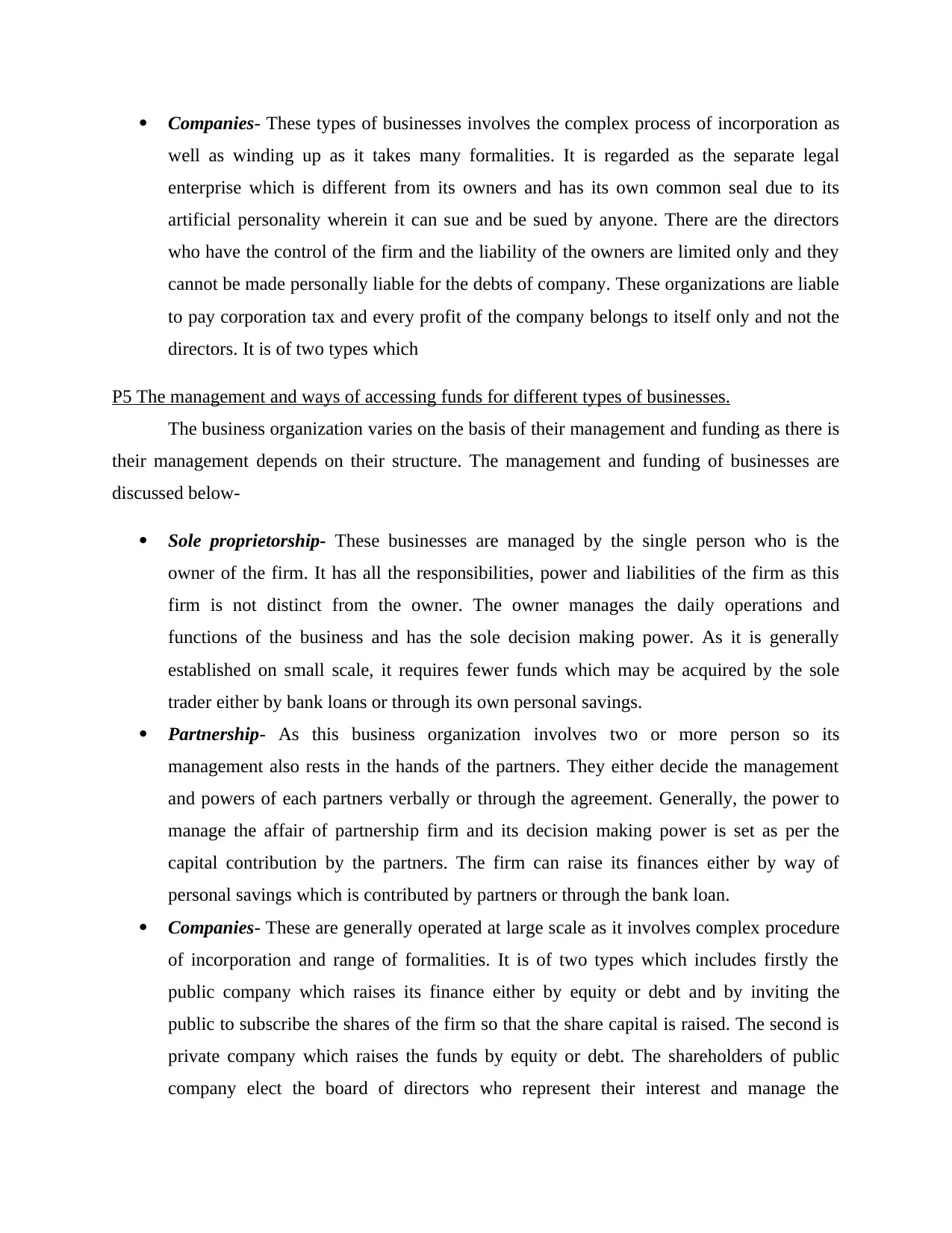
Companies- These types of businesses involves the complex process of incorporation as
well as winding up as it takes many formalities. It is regarded as the separate legal
enterprise which is different from its owners and has its own common seal due to its
artificial personality wherein it can sue and be sued by anyone. There are the directors
who have the control of the firm and the liability of the owners are limited only and they
cannot be made personally liable for the debts of company. These organizations are liable
to pay corporation tax and every profit of the company belongs to itself only and not the
directors. It is of two types which
P5 The management and ways of accessing funds for different types of businesses.
The business organization varies on the basis of their management and funding as there is
their management depends on their structure. The management and funding of businesses are
discussed below-
Sole proprietorship- These businesses are managed by the single person who is the
owner of the firm. It has all the responsibilities, power and liabilities of the firm as this
firm is not distinct from the owner. The owner manages the daily operations and
functions of the business and has the sole decision making power. As it is generally
established on small scale, it requires fewer funds which may be acquired by the sole
trader either by bank loans or through its own personal savings.
Partnership- As this business organization involves two or more person so its
management also rests in the hands of the partners. They either decide the management
and powers of each partners verbally or through the agreement. Generally, the power to
manage the affair of partnership firm and its decision making power is set as per the
capital contribution by the partners. The firm can raise its finances either by way of
personal savings which is contributed by partners or through the bank loan.
Companies- These are generally operated at large scale as it involves complex procedure
of incorporation and range of formalities. It is of two types which includes firstly the
public company which raises its finance either by equity or debt and by inviting the
public to subscribe the shares of the firm so that the share capital is raised. The second is
private company which raises the funds by equity or debt. The shareholders of public
company elect the board of directors who represent their interest and manage the
well as winding up as it takes many formalities. It is regarded as the separate legal
enterprise which is different from its owners and has its own common seal due to its
artificial personality wherein it can sue and be sued by anyone. There are the directors
who have the control of the firm and the liability of the owners are limited only and they
cannot be made personally liable for the debts of company. These organizations are liable
to pay corporation tax and every profit of the company belongs to itself only and not the
directors. It is of two types which
P5 The management and ways of accessing funds for different types of businesses.
The business organization varies on the basis of their management and funding as there is
their management depends on their structure. The management and funding of businesses are
discussed below-
Sole proprietorship- These businesses are managed by the single person who is the
owner of the firm. It has all the responsibilities, power and liabilities of the firm as this
firm is not distinct from the owner. The owner manages the daily operations and
functions of the business and has the sole decision making power. As it is generally
established on small scale, it requires fewer funds which may be acquired by the sole
trader either by bank loans or through its own personal savings.
Partnership- As this business organization involves two or more person so its
management also rests in the hands of the partners. They either decide the management
and powers of each partners verbally or through the agreement. Generally, the power to
manage the affair of partnership firm and its decision making power is set as per the
capital contribution by the partners. The firm can raise its finances either by way of
personal savings which is contributed by partners or through the bank loan.
Companies- These are generally operated at large scale as it involves complex procedure
of incorporation and range of formalities. It is of two types which includes firstly the
public company which raises its finance either by equity or debt and by inviting the
public to subscribe the shares of the firm so that the share capital is raised. The second is
private company which raises the funds by equity or debt. The shareholders of public
company elect the board of directors who represent their interest and manage the
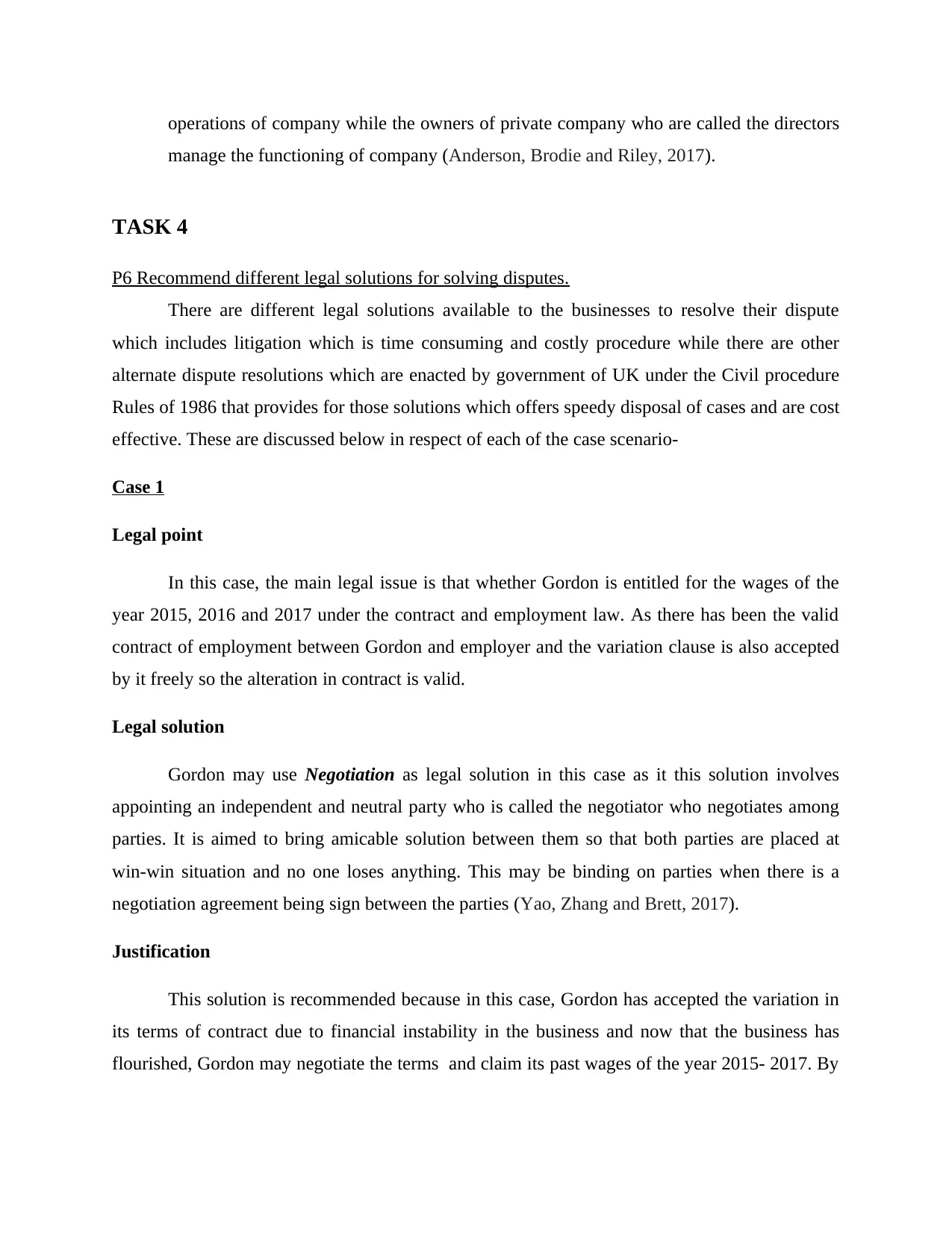
operations of company while the owners of private company who are called the directors
manage the functioning of company (Anderson, Brodie and Riley, 2017).
TASK 4
P6 Recommend different legal solutions for solving disputes.
There are different legal solutions available to the businesses to resolve their dispute
which includes litigation which is time consuming and costly procedure while there are other
alternate dispute resolutions which are enacted by government of UK under the Civil procedure
Rules of 1986 that provides for those solutions which offers speedy disposal of cases and are cost
effective. These are discussed below in respect of each of the case scenario-
Case 1
Legal point
In this case, the main legal issue is that whether Gordon is entitled for the wages of the
year 2015, 2016 and 2017 under the contract and employment law. As there has been the valid
contract of employment between Gordon and employer and the variation clause is also accepted
by it freely so the alteration in contract is valid.
Legal solution
Gordon may use Negotiation as legal solution in this case as it this solution involves
appointing an independent and neutral party who is called the negotiator who negotiates among
parties. It is aimed to bring amicable solution between them so that both parties are placed at
win-win situation and no one loses anything. This may be binding on parties when there is a
negotiation agreement being sign between the parties (Yao, Zhang and Brett, 2017).
Justification
This solution is recommended because in this case, Gordon has accepted the variation in
its terms of contract due to financial instability in the business and now that the business has
flourished, Gordon may negotiate the terms and claim its past wages of the year 2015- 2017. By
manage the functioning of company (Anderson, Brodie and Riley, 2017).
TASK 4
P6 Recommend different legal solutions for solving disputes.
There are different legal solutions available to the businesses to resolve their dispute
which includes litigation which is time consuming and costly procedure while there are other
alternate dispute resolutions which are enacted by government of UK under the Civil procedure
Rules of 1986 that provides for those solutions which offers speedy disposal of cases and are cost
effective. These are discussed below in respect of each of the case scenario-
Case 1
Legal point
In this case, the main legal issue is that whether Gordon is entitled for the wages of the
year 2015, 2016 and 2017 under the contract and employment law. As there has been the valid
contract of employment between Gordon and employer and the variation clause is also accepted
by it freely so the alteration in contract is valid.
Legal solution
Gordon may use Negotiation as legal solution in this case as it this solution involves
appointing an independent and neutral party who is called the negotiator who negotiates among
parties. It is aimed to bring amicable solution between them so that both parties are placed at
win-win situation and no one loses anything. This may be binding on parties when there is a
negotiation agreement being sign between the parties (Yao, Zhang and Brett, 2017).
Justification
This solution is recommended because in this case, Gordon has accepted the variation in
its terms of contract due to financial instability in the business and now that the business has
flourished, Gordon may negotiate the terms and claim its past wages of the year 2015- 2017. By
⊘ This is a preview!⊘
Do you want full access?
Subscribe today to unlock all pages.

Trusted by 1+ million students worldwide
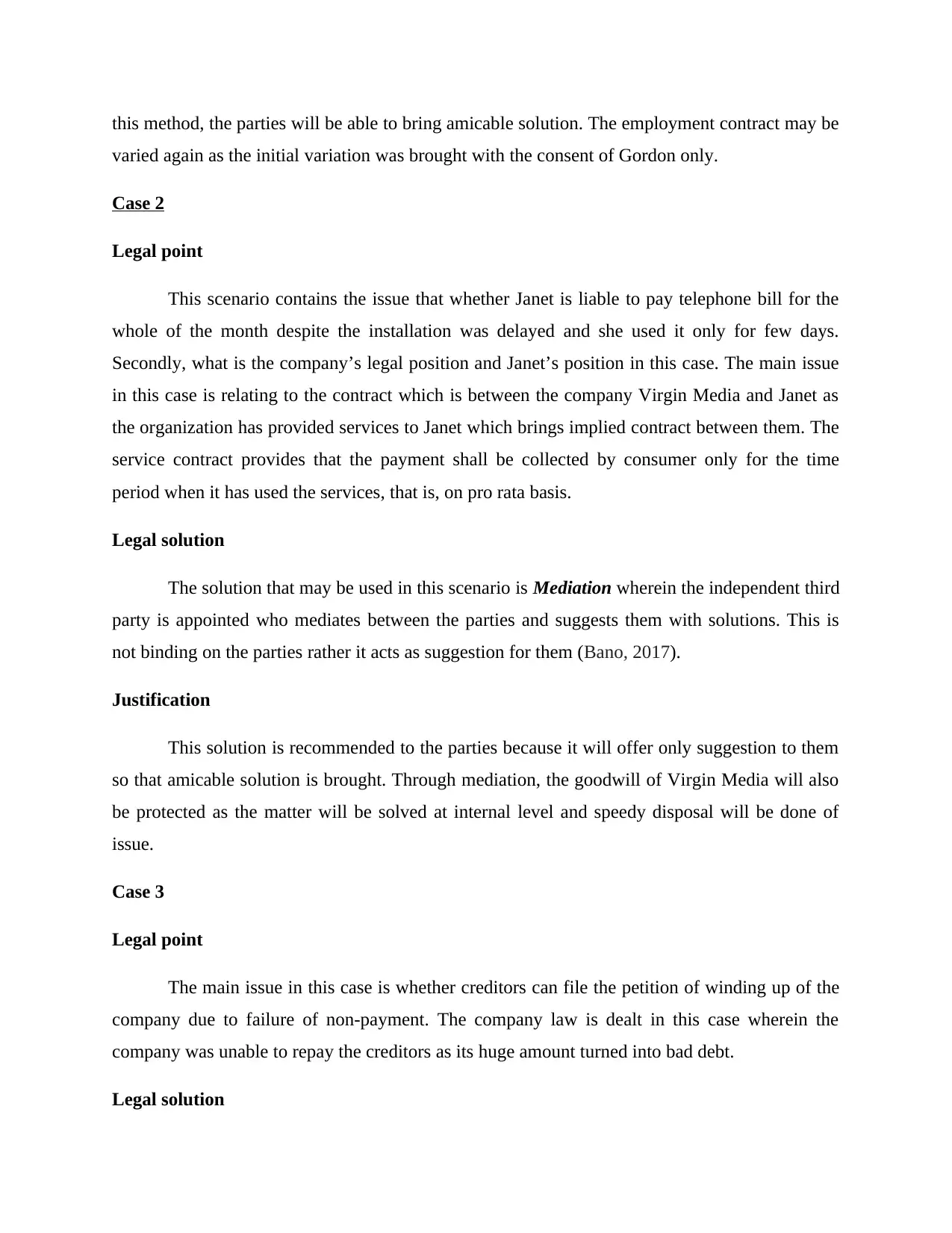
this method, the parties will be able to bring amicable solution. The employment contract may be
varied again as the initial variation was brought with the consent of Gordon only.
Case 2
Legal point
This scenario contains the issue that whether Janet is liable to pay telephone bill for the
whole of the month despite the installation was delayed and she used it only for few days.
Secondly, what is the company’s legal position and Janet’s position in this case. The main issue
in this case is relating to the contract which is between the company Virgin Media and Janet as
the organization has provided services to Janet which brings implied contract between them. The
service contract provides that the payment shall be collected by consumer only for the time
period when it has used the services, that is, on pro rata basis.
Legal solution
The solution that may be used in this scenario is Mediation wherein the independent third
party is appointed who mediates between the parties and suggests them with solutions. This is
not binding on the parties rather it acts as suggestion for them (Bano, 2017).
Justification
This solution is recommended to the parties because it will offer only suggestion to them
so that amicable solution is brought. Through mediation, the goodwill of Virgin Media will also
be protected as the matter will be solved at internal level and speedy disposal will be done of
issue.
Case 3
Legal point
The main issue in this case is whether creditors can file the petition of winding up of the
company due to failure of non-payment. The company law is dealt in this case wherein the
company was unable to repay the creditors as its huge amount turned into bad debt.
Legal solution
varied again as the initial variation was brought with the consent of Gordon only.
Case 2
Legal point
This scenario contains the issue that whether Janet is liable to pay telephone bill for the
whole of the month despite the installation was delayed and she used it only for few days.
Secondly, what is the company’s legal position and Janet’s position in this case. The main issue
in this case is relating to the contract which is between the company Virgin Media and Janet as
the organization has provided services to Janet which brings implied contract between them. The
service contract provides that the payment shall be collected by consumer only for the time
period when it has used the services, that is, on pro rata basis.
Legal solution
The solution that may be used in this scenario is Mediation wherein the independent third
party is appointed who mediates between the parties and suggests them with solutions. This is
not binding on the parties rather it acts as suggestion for them (Bano, 2017).
Justification
This solution is recommended to the parties because it will offer only suggestion to them
so that amicable solution is brought. Through mediation, the goodwill of Virgin Media will also
be protected as the matter will be solved at internal level and speedy disposal will be done of
issue.
Case 3
Legal point
The main issue in this case is whether creditors can file the petition of winding up of the
company due to failure of non-payment. The company law is dealt in this case wherein the
company was unable to repay the creditors as its huge amount turned into bad debt.
Legal solution
Paraphrase This Document
Need a fresh take? Get an instant paraphrase of this document with our AI Paraphraser
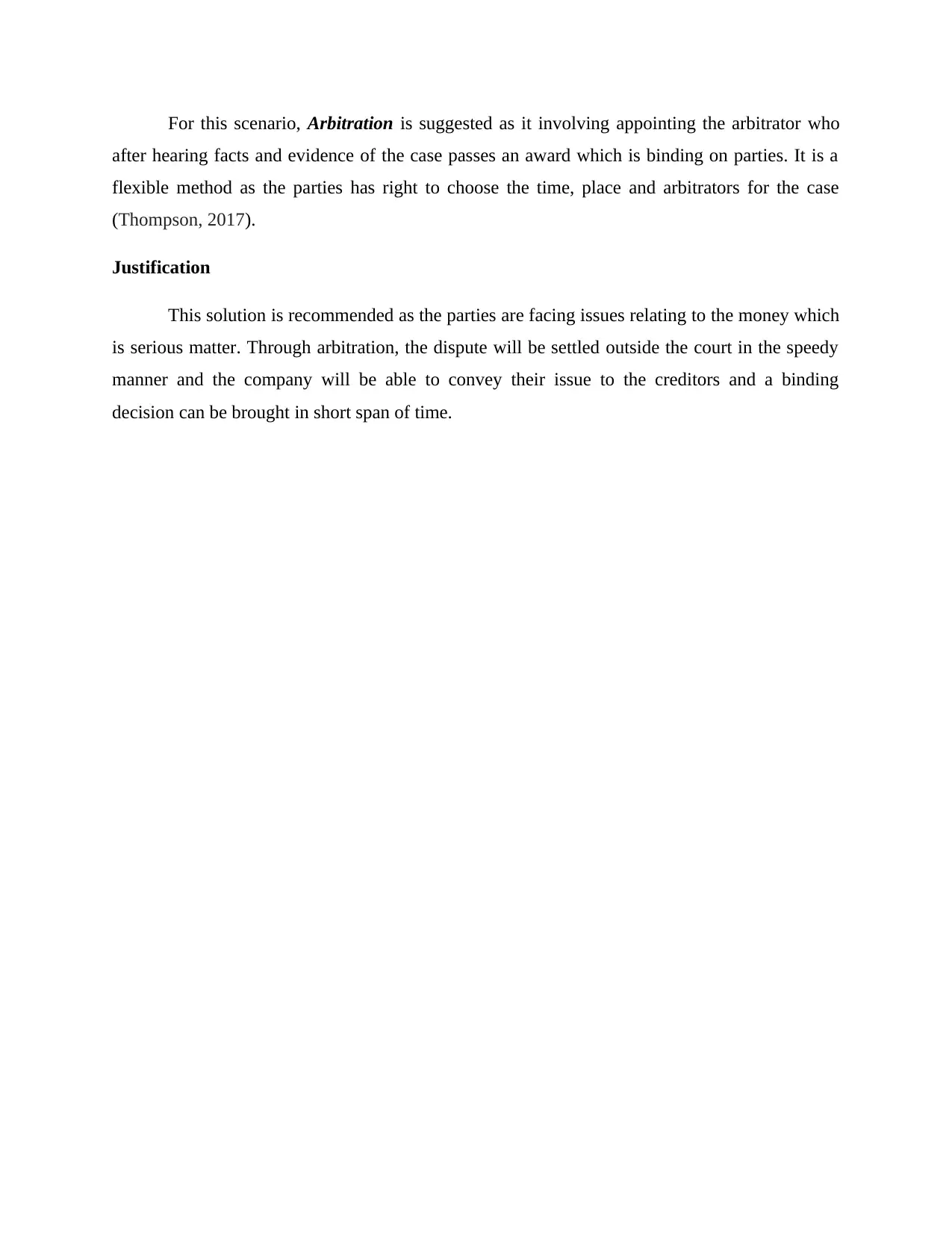
For this scenario, Arbitration is suggested as it involving appointing the arbitrator who
after hearing facts and evidence of the case passes an award which is binding on parties. It is a
flexible method as the parties has right to choose the time, place and arbitrators for the case
(Thompson, 2017).
Justification
This solution is recommended as the parties are facing issues relating to the money which
is serious matter. Through arbitration, the dispute will be settled outside the court in the speedy
manner and the company will be able to convey their issue to the creditors and a binding
decision can be brought in short span of time.
after hearing facts and evidence of the case passes an award which is binding on parties. It is a
flexible method as the parties has right to choose the time, place and arbitrators for the case
(Thompson, 2017).
Justification
This solution is recommended as the parties are facing issues relating to the money which
is serious matter. Through arbitration, the dispute will be settled outside the court in the speedy
manner and the company will be able to convey their issue to the creditors and a binding
decision can be brought in short span of time.
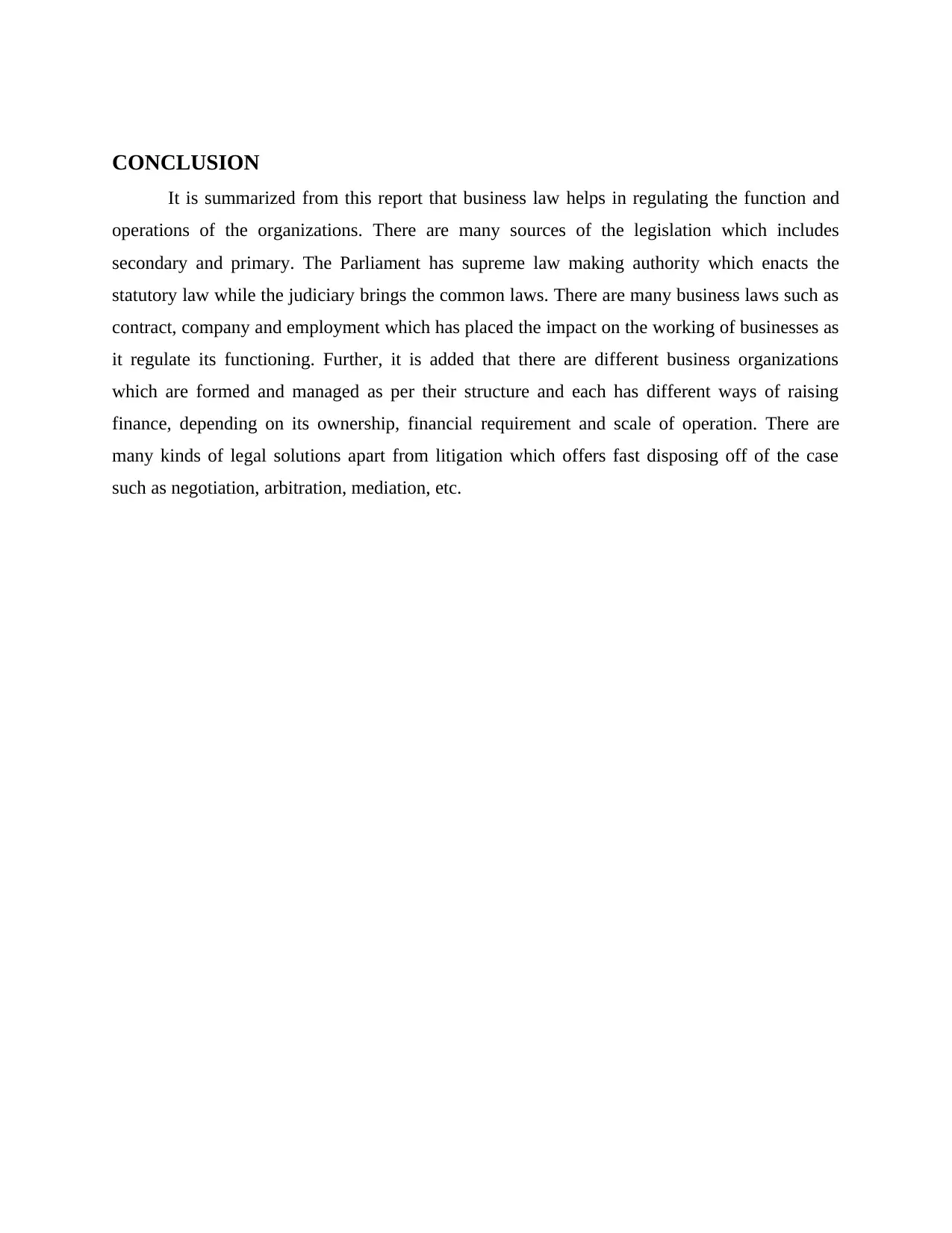
CONCLUSION
It is summarized from this report that business law helps in regulating the function and
operations of the organizations. There are many sources of the legislation which includes
secondary and primary. The Parliament has supreme law making authority which enacts the
statutory law while the judiciary brings the common laws. There are many business laws such as
contract, company and employment which has placed the impact on the working of businesses as
it regulate its functioning. Further, it is added that there are different business organizations
which are formed and managed as per their structure and each has different ways of raising
finance, depending on its ownership, financial requirement and scale of operation. There are
many kinds of legal solutions apart from litigation which offers fast disposing off of the case
such as negotiation, arbitration, mediation, etc.
It is summarized from this report that business law helps in regulating the function and
operations of the organizations. There are many sources of the legislation which includes
secondary and primary. The Parliament has supreme law making authority which enacts the
statutory law while the judiciary brings the common laws. There are many business laws such as
contract, company and employment which has placed the impact on the working of businesses as
it regulate its functioning. Further, it is added that there are different business organizations
which are formed and managed as per their structure and each has different ways of raising
finance, depending on its ownership, financial requirement and scale of operation. There are
many kinds of legal solutions apart from litigation which offers fast disposing off of the case
such as negotiation, arbitration, mediation, etc.
⊘ This is a preview!⊘
Do you want full access?
Subscribe today to unlock all pages.

Trusted by 1+ million students worldwide
1 out of 13
Related Documents
Your All-in-One AI-Powered Toolkit for Academic Success.
+13062052269
info@desklib.com
Available 24*7 on WhatsApp / Email
![[object Object]](/_next/static/media/star-bottom.7253800d.svg)
Unlock your academic potential
Copyright © 2020–2025 A2Z Services. All Rights Reserved. Developed and managed by ZUCOL.





